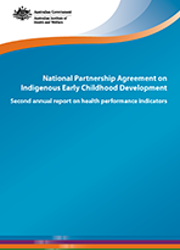National Partnership Agreement on Indigenous Early Childhood Development: second annual report on health performance indicators
Citation
AIHW
Australian Institute of Health and Welfare (2015) National Partnership Agreement on Indigenous Early Childhood Development: second annual report on health performance indicators, AIHW, Australian Government, accessed 24 April 2024.
APA
Australian Institute of Health and Welfare. (2015). National Partnership Agreement on Indigenous Early Childhood Development: second annual report on health performance indicators. Canberra: AIHW.
MLA
Australian Institute of Health and Welfare. National Partnership Agreement on Indigenous Early Childhood Development: second annual report on health performance indicators. AIHW, 2015.
Vancouver
Australian Institute of Health and Welfare. National Partnership Agreement on Indigenous Early Childhood Development: second annual report on health performance indicators. Canberra: AIHW; 2015.
Harvard
Australian Institute of Health and Welfare 2015, National Partnership Agreement on Indigenous Early Childhood Development: second annual report on health performance indicators, AIHW, Canberra.
PDF | 2.1Mb
This is the second annual performance report for the National Partnership Agreement on Indigenous Early Childhood Development. It provides the latest available information, as well as trends on the 6 health-related indicators in the partnership agreement. Key findings include:-The gap in low birthweight rates between babies of Indigenous and non-Indigenous mothers narrowed substantially between 2000 and 2010.-Indigenous mothers were more likely than non-Indigenous mothers to have smoked during pregnancy, and accessed antenatal care less often.-The infant mortality rate for Indigenous infants between 2001 and 2011 declined by 55%, but remained almost twice as high as for non-Indigenous infants.
- ISBN: 978-1-74249-691-7
- Cat. no: IHW 151
- Pages: 124
-
Indigenous mothers access antenatal care later and less often than other mothers
-
The proportion of low birthweight babies born to Indigenous mothers declined substantially between 2000 and 2010
-
Indigenous mothers were almost 4 times as likely as non-Indigenous mothers to have smoked during pregnancy
-
Rates for chlamydia, gonorrhoea and syphilis were much higher for Indigenous teenagers than for other teenagers



